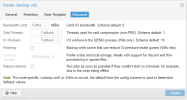Sorry to bug you. There are so many people waiting for this feature.
Can you give us some crumbs?
--------------------------------------------------------------------------
See here.
https://lists.proxmox.com/pipermail/pve-devel/2024-January/061470.html
When a backup for a VM is started, QEMU will install a
"copy-before-write" filter in its block layer. This filter ensures
that upon new guest writes, old data still needed for the backup is
sent to the backup target first. The guest write blocks until this
operation is finished so guest IO to not-yet-backed-up sectors will be
limited by the speed of the backup target.
With backup fleecing, such old data is cached in a fleecing image
rather than sent directly to the backup target. This can help guest IO
performance and even prevent hangs in certain scenarios, at the cost
of requiring more storage space.
Can you give us some crumbs?
--------------------------------------------------------------------------
See here.
https://lists.proxmox.com/pipermail/pve-devel/2024-January/061470.html
When a backup for a VM is started, QEMU will install a
"copy-before-write" filter in its block layer. This filter ensures
that upon new guest writes, old data still needed for the backup is
sent to the backup target first. The guest write blocks until this
operation is finished so guest IO to not-yet-backed-up sectors will be
limited by the speed of the backup target.
With backup fleecing, such old data is cached in a fleecing image
rather than sent directly to the backup target. This can help guest IO
performance and even prevent hangs in certain scenarios, at the cost
of requiring more storage space.


